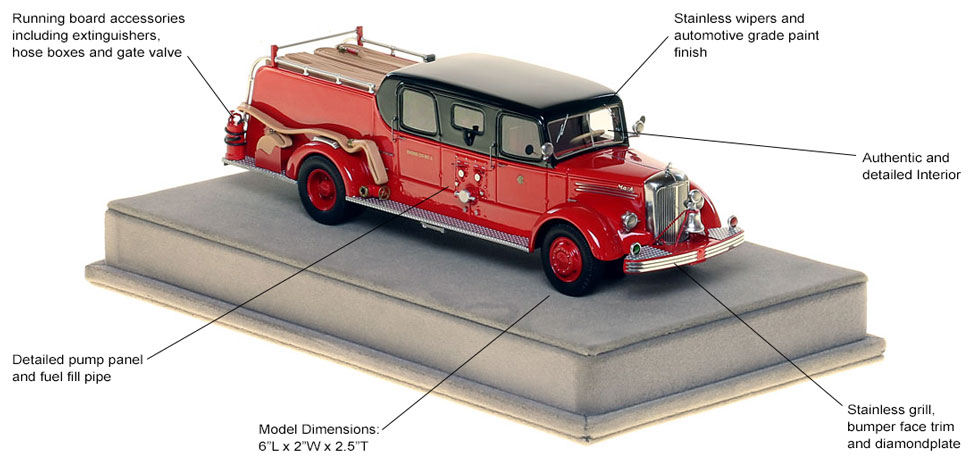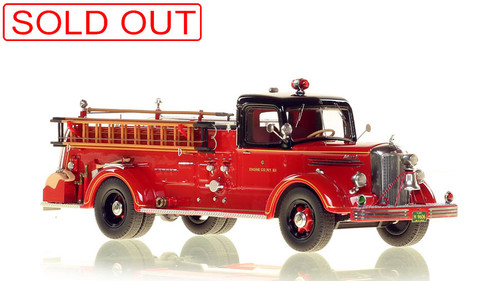Chicago Fire Department 1948 Mack® L Sedan Cab Engine 5 scale model

The next addition to your vintage Chicago fire truck collection
This 1:50 scale model of Chicago Fire Department's 1948 Mack L Sedan Cab Engine is a museum grade masterpiece, and a worthy addition to elite Chicago collections.

Only 75 units available of this hand-crafted, museum grade replica
Fire Replicas manufactures true collectibles in limited quantities for enhanced long-term value. Once fully sold, no additional units will be produced.









Chicago Fire Department 1948 Mack® L Sedan Cab Engine scale model specs
- Scale: 1:50
- Production Quantity: 75 each of Engine Companies 5, 17, 34 and 42.
- Multi-materials including High Def Resin, stainless steel photo etch metal, wire, rubber and other composites.
- Mounted inside high quality, custom display case featuring etched stainless steel I.D. nameplate.
- Model Dimensions: 6.75"L x 2"W x 2.25"T
- Display Case Dimensions: 8"L x 4.5"W x 4"T






History of Chicago Engine 5 by Joe O'Brien
In 1859 the Volunteer Engine 5 ‘Excelsior’ was placed out of service. In 1860 the paid Chicago Fire Department, Engine 5 ‘U.P. Harris’ was organized. During the transition period from Volunteer to paid it was normal to have the the steamers and rigs with names. U.P. Harris was the Chief Engineer of the Town of Chicago Volunteer fire department which was organized in 1835. As the city grew, the volunteer department would change to a paid department in 1858.
Engine 5 received its new Silsby steamer in 1868 “Chicago”. In 1871 Engine 5 moved in to a new 2 bay firehouse at 326 S Jefferson with Truck 2 ‘Protector’. Engine 5 received its first motorized rig in 1912 which was a Nott/Steamer at the same time Wagon 12 got a 1912 Harder. In 1923 Water Tower 1 was organized in this firehouse (Fire Replicas 1923 Water Tower). The firehouse location was west of the south branch of the Chicago river and spared by the Great Chicago Fire of 1871. In 1928 a company wanted to expand its building on the grounds of where Engine 5’s firehouse was. The city sold the building to the company and exchanged land with the company a block to the west on Desplanes. In 1928 the new 3 bay firehouse opened with Engine 5, Water Tower 1(the 1928 Fire Replicas model) and High Pressure 1. This is still an active firehouse.
Engine 5’s third motorized rig at this station was the 1948 Mack Sedan which was in service until 1964. Fire Replicas has reproduced engine 5’s 48 Mack L Sedan. This could look display well with the 1928 Seagrave Water Tower 1 or a 1954 FWD tiller.
For you rig fans the Fire Replicas 1928 WT 1 ran from here from 1928 until 1959. Squad 2, Salvage Squad 1 and 2 ran the 1952 Autocars from here. The 1982 Chicago Snorkel that Fire Replicas replicated also ran from here as Squad 1A when squad 1 was quartered here.
More About the Scale Model
This Chicago Fire Department 1948 Mack® L Sedan Cab Engine scale model is a museum grade replica. Like all Fire Replicas models, every detail is modeled to perfection and with razor sharp precision. The replica features the specific department configuration and graphics, leaving no detail overlooked. The display case is custom manufactured with high quality acrylic and resin. The stainless steel etched plate features the department and truck name, and department seal. This replica is a treasure to be displayed and admired and is in no way a toy.
Safety Warning
This is not a toy and not suitable for children under the age of 14. This highly detailed scale model contains small, intricate pieces that may present a choking hazard.
The Mack trademarks and bulldog hood ornament are registered rights of the AB Volvo Group and are used pursuant to a license.














